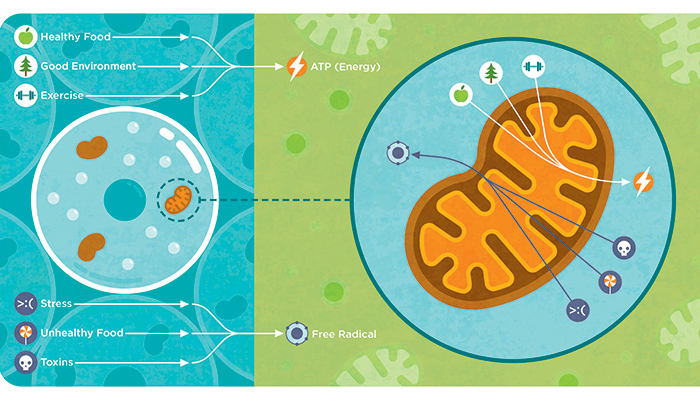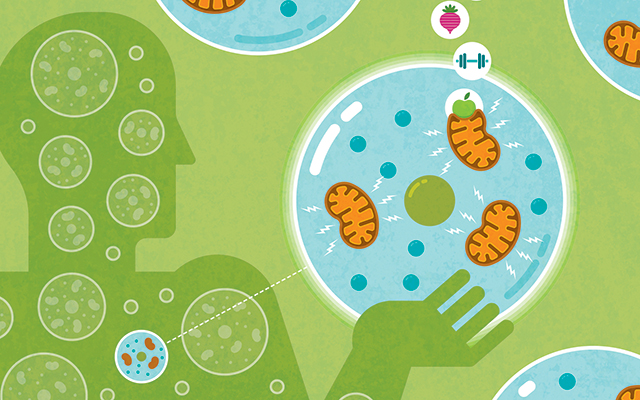Explore this article:
Why Mitochondria Matter | How to Improve Mitochondrial Function | How to Heal Damaged Mitochondria | 7 Ways to Bolster Your Mitochondria
We spend billions of dollars every year buying pills, potions, and creams that promise to slow the aging process. But what if we could enlist our own bodies to help us live longer, healthier lives?
Meet your mitochondria — the tiny factories in each of our cells that turn the food we eat and the oxygen we breathe into energy.
When the communication breaks down between our cells’ nuclei and their mitochondria, aging accelerates.
But here’s the exciting news — the opposite is also true: When intracellular communication is improved, the aging process slows down, and overall health and vitality improve.
Researchers used to think that unavoidable mitochondrial mutations were to blame for such aging-related miscommunications, but they’ve now discovered that such disconnects can be repaired if the mutations have not advanced too far.
“The aging process, we discovered, is like a married couple,” states Harvard Medical School biologist David Sinclair, PhD. “When they are young, they communicate well. But over time, living in close quarters for many years, communication breaks down.”
Fortunately, Sinclair notes, “restoring communication solves the problem.”
The great thing is, caring for your mitochondria and upgrading their communication network doesn’t just help slow down the aging process. It can also enhance your energy, metabolism, and cognitive powers. And it can reduce your risk of age-related diseases like cancer, Alzheimer’s, heart disease, and infertility.
Ready to embark on a mitochondrial makeover? Here’s what you need to know about your body’s primary power source.
Why Mitochondria Matter
First, to grasp the sheer scale of mitochondria’s impact on our overall health, consider this:
Each of us has quadrillions (that’s thousands of trillions) of these energy factories in our bodies.
Each mitochondrion is filled with some 17,000 biochemical assembly lines, all designed to produce a molecule called adenosine triphosphate, or ATP — our bodies’ major, most elemental fuel.
The more energy a tissue or organ demands for proper function, the more mitochondria its cells contain. Mitochondria are especially abundant in the cells that make up our hearts, brains, and muscles.
In fact, the heart is so energy-intensive that up to 40 percent of the space in its cells is taken up with mitochondrial power plants.
The heart is so energy-intensive that up to 40 percent of the space in its cells is taken up with mitochondrial power plants.
The density and health of the mitochondria in your organs and muscles are, to a large extent, a reflection of your current level of health and fitness. (Lean muscle tissue, for example, contains far more mitochondria than fat does, and a strong heart is likely to be denser with mitochondria than a weak one.)
The more healthy mitochondria your body contains, the better you’ll feel, and the more robust your metabolism will be. A mighty mitochondrial force translates to better energy and focus, and greater ability to sustain high levels of activity without fatiguing.
Mitochondria produce energy by breaking down food, explains Bruce H. Cohen, MD, a neurologist at Northeast Ohio Medical University and an expert in mitochondrial disease. Then they release that energy in the form of ATP, along with some byproducts, like carbon dioxide, water, and free radicals.
Free radicals are charged, highly active molecules that careen around the body, reacting with tissue. In moderation, free radicals can help us fight infection. In excess, however, they wreak havoc, damaging cell tissue, eroding our bodies, and causing runaway inflammation. (For more on free radicals, see “How Antioxidants Can Slow Free-Radical Damage.”)
The more healthy mitochondria your body contains, the better you’ll feel, and the more robust your metabolism will be.
The health implications of such mitochondria-related damage can be far-reaching, says pediatric neurologist Jong Rho, MD, of the University of Calgary and Alberta Children’s Hospital.
When children are born with genetic defects that negatively affect their mitochondria, he explains, the downstream effects can include loss of motor control, muscle weakness and pain, gastrointestinal disorders, swallowing difficulties, poor growth, cardiac disease, liver disease, type 2 diabetes, respiratory complications, seizures, visual or hearing problems, developmental delays, and susceptibility to infection — just to name a few.
But even those of us who start life with healthy mitochondria can undermine and deplete them through basic wear and tear, or through outright abuse.
Stress, sedentary lifestyles, free-radical damage, and exposure to infections, allergens, and toxins can all cause our energy-generation network to falter.
But one of the chief reasons our mitochondria deteriorate, says Cohen, is that we eat an excess of poor-quality foods and a deficit of healthy ones. The empty calories of sugars, flours, and other processed foods force mitochondria to burn through a great deal of junk — generating free radicals and inflammation as they go — before useful nutrients can be siphoned out.
One of the chief reasons our mitochondria deteriorate, is that we eat an excess of poor-quality foods and a deficit of healthy ones. The empty calories of sugars, flours, and other processed foods force mitochondria to burn through a great deal of junk — generating free radicals and inflammation as they go — before useful nutrients can be siphoned out.
The glycemic impact of such foods (to say nothing of their trans fats, chemical additives, and other proinflammatory factors) only exacerbates the damage.
And unless we are eating plenty of phytonutrients, antioxidants, healthy fats, proteins, and fiber, we aren’t giving our bodies the basic tools they need to repair the damage.
The overfeeding and undernourishing of our mitochondria help explain the twin epidemics of obesity and type 2 diabetes, Cohen says.
The overworked pancreas produces so much insulin that it may burn out — or, alternatively, overwhelm the receptors on cell membranes until they become resistant to insulin and unable to transport it to the cells’ mitochondria for energy production.
It’s important to recognize, Cohen adds, that from a genetic standpoint, our mitochondria were never designed for the food environment and lifestyle to which we now subject them.
Furthermore, he argues, our ancestors rarely lived to 70, 80, or 90 years. So we now are asking our mitochondria to perform longer under far more challenging conditions.
The net result: Unless we take good care of our mitochondria, at minimum we are likely to feel fatigued and fuzzy-brained. We also run a greater risk for a number of ailments, including obesity, type 2 diabetes, and neurodegenerative disease.
The Relationship Between Nutrition and Mitochondrial Health

There is perhaps no one who has a better understanding of the relationship between nutrition and mitochondrial health than Terry Wahls, MD, clinical professor of medicine at the University of Iowa.
Wahls, diagnosed with multiple sclerosis (MS) more than a decade ago, credits an intensive nutritional strategy with helping her to overcome the neurodegenerative brain disease (see “Curing the ‘Uncurable,’” below and “How Terry Wahls, MD, Beat Multiple Sclerosis (MS)“).
In her book, The Wahls Protocol, she outlines how she repaired her mitochondria and recovered her health by combining a Paleolithic diet, targeted supplementation, and other lifestyle adjustments.
For both general and mitochondrial health, Wahls recommends avoiding foods containing gluten, as well as dairy products, eggs, processed meats containing nitrates, and anything sweetened with sugar. For those especially concerned with their health, Wahls also recommends avoiding all grains, legumes, peanuts, and soy.
Beyond removing these foods, Wahls suggests eating six to nine cups of vegetables and fruits daily, including three green, three deeply colored, and three rich in sulfur (e.g., arugula, broccoli, bok choy). She also recommends eating 6 to 12 ounces of grassfed meat or wild-caught fish daily, plus, for die-hard types, a 14-fluid-ounce can of full-fat coconut milk.
At full force, Wahls’s diet becomes “ketogenic” — that is, so low in carbs and high in fat that the body stops getting energy from glucose (which comes from carbs) and starts burning fat instead.
During ketogenesis, fatty acids enter the liver, which breaks them down into “ketone bodies,” water-soluble biochemicals that can be used for energy, especially in the heart and the brain (two of the body’s most mitochondria-dense regions).
Although Wahls’s work with the ketogenic diet has been largely clinical, there’s strong laboratory evidence for the approach, and a powerful biochemical rationale behind it.
One of its leading advocates is neurologist Jong Rho, who says that in battling mitochondrial dysfunction, ketogenic diets may rank among the most promising treatment strategies available. “When mitochondria are fueled by ketones instead of glucose,” Rho explains, “their ability to produce ATP is enhanced and free-radical byproducts are reduced.”
Rho references laboratory evidence showing that a ketogenic diet can be protective against many diseases that affect the brain and nervous system (and where mitochondrial function is key), including Alzheimer’s, Parkinson’s, epilepsy, autism, even malignant brain cancer.
(See “What You Need to Know About the Keto Diet” for expert explanations on the pros and cons of this popular protocol.)
How to Heal Damaged Mitochondria — Naturally
Targeted supplementation can also help reverse mitochondrial decline. At the forefront of this research is preeminent biochemist Bruce Ames, PhD, a professor emeritus at the University of California, Berkeley, and senior scientist at Children’s Hospital Oakland Research Institute.
For years now, Ames has been working on ways to protect and restore mitochondria in the brain. His goal is to halt and even reverse the cognitive and neurologic decline that usually comes with age.
Targeted supplementation can also help reverse mitochondrial decay.
Ames’s first line of attack was to try to reverse the mitochondrial deterioration that produces excess free radicals, a process he compares to “an old car engine producing too much smoke,” and thus, not running efficiently.
Aging mitochondria, with their inefficient machinery, damaged DNA, and decaying membranes, can’t clear the smoke, which leads to impaired memory and mental function over time.
The only means Ames knew to slow the process in animals was calorie restriction — flat-out reducing the amount of fuel burned. But it’s hard (and not healthy) to starve humans, so Ames vowed to find another way.
He experimented in the lab, trying out various supplements on a group of aging rats. Acetyl-L-carnitine (ALC), which is known for transporting fatty acids into the mitochondria, shored up the membranes and helped repair the mitochondrial DNA, but it didn’t decrease free-radical production. So, he added alpha-lipoic acid (LA), a mitochondrial coenzyme capable of cleaning up the messes free radicals make.
The result? Ames’s older lab rats — who couldn’t run well on a treadmill and couldn’t navigate in a water pool — were rejuvenated. Their running and swimming improved. Their mitochondria became more youthful, too.
Ames discovered that a host of different micronutrients are involved in mitochondrial health. Looking at human cells, for example, Ames found damage to DNA whenever even one of a number of minerals or vitamins was removed.
To explain the phenomenon, Ames came up with a theory rooted in our hunter-gatherer past, when micronutrient shortages must have been recurrent: To make sure the species was perpetuated, natural selection imposed a “strategic rationing response,” shunting the vital nutrients toward functions essential for short-term survival and reproduction, and away from longevity systems affected by dysfunctional mitochondria.
Joyce McCann, PhD, who works in Ames’s lab, suggests that this metabolic tradeoff accelerates diseases, such as cancer, cardiovascular disease, immune dysfunction, and cognitive decline.
Although a variety of lifestyle factors contribute to mitochondrial health, says Ames (see “7 Ways to Bolster Your Mitochondria” below), the single most important thing we can do is to eat a well-balanced, whole-foods diet.
Because research suggests that virtually all U.S. adults are deficient in one or more important nutrients, many experts recommend supplementing with a high-quality multivitamin, vitamin D, essential fatty acids — and perhaps more, depending on your individual profile.
But a cautionary note comes from Bruce Cohen, who points out that many nutrition studies have been done only with mice or cell cultures. “When you try the strategies on humans,” he says, “they don’t always work.”
Wahls is trying to set that right. Her pilot study on the Wahls Protocol, which studied 13 MS patients, was published in The Journal of Alternative and Complementary Medicine earlier this year. Within the study group, six people rigorously adhered to the protocol — including a paleo diet, exercise, meditation, and massage — for a full year. Those patients, who normally would have experienced only further decline, showed clinically significant improvement in fatigue symptoms compared with their baseline assessments.
A great deal more research is necessary, notes Wahls. But eating for your mitochondria, she argues, is almost guaranteed to pay off. “I am the canary in the coal mine, here as a warning to all of you,” Wahls says. “If we don’t care for our mitochondria, we will pay a very high price when it comes to our health.”
7 Ways to Repair and Increase Mitochondria Energy
Caring for your mitochondria is one of the best ways to take care of your health — and enjoy better energy, metabolism, and mental focus in the process.
- Do strength training and high-intensity interval training (HIIT). Both can increase the number, and improve the function, of your mitochondria. The better your muscle mass and cardiovascular conditioning, the better your mitochondria will fare, and the more powerfully they will perform.
- Avoid or eliminate ingredients that are toxic to your mitochondria, including processed flours, all sugars and refined sweeteners, trans fats, gluten, and dairy products.
- Eat six to nine cups of fresh vegetables and fruits daily. Terry Wahls, MD, recommends a variety of greens (broccoli, bok choy, etc.), brightly colored vegetables (beets, carrots, etc.), and the sulfur-rich veggies (cauliflower, cabbage, etc.) that help your body produce glutathione, a master antioxidant. She recommends blending several of your mitochondrial-building veggies and fruits in a daily smoothie.
- Dine on fiber-rich foods to help detox the poisons that can build up when mitochondria slow down. (See “6 Ways to Eat More Fiber“.)
- Up your omega-3 fat intake to help build your mitochondrial membranes. Wahls recommends consuming 6 to 12 ounces of grassfed meat or low-mercury wild-caught fish each day. Avocados, nuts, and seeds are also rich in fatty acids. Taking a fish-oil supplement is a good idea for most people.
- Brew up bone broth. When mitochondria are compromised, there is increased risk for autoimmune diseases, such as arthritis, which are caused, in part, by a leaky gut. Wahls says bone broth is rich in glutamine and other amino acids that are especially good for healing a leaky gut as well as other ailments. “It’s the secret to that old-fashioned chicken soup remedy,” she notes, “as long as you cook that soup broth with the chicken bones.”
- Take mitochondria-protective and energy-boosting micronutrients, such as Acetyl-L-carnitine, alpha-lipoic acid, coenzyme Q10, N-acetylcysteine, NADH, D-ribose, resveratrol, and magnesium aspartate.
Download the “7 Ways to Bolster Your Mitochondria” PDF.
Curing the “Uncurable”
How Terry Wahls, MD, and her mitochondria beat multiple sclerosis.
 When Terry Wahls was in college, she loved tae kwon do so much that she focused on it until she became a national champion. She later went to med school and pursued an academic career at the University of Iowa and the Iowa City VA Medical Center.
When Terry Wahls was in college, she loved tae kwon do so much that she focused on it until she became a national champion. She later went to med school and pursued an academic career at the University of Iowa and the Iowa City VA Medical Center.
Her life took a sharp detour in 2000, when she developed multiple sclerosis (MS), a chronic autoimmune disease with no known cure. Wahls went to the Cleveland Clinic and had access to the latest drugs. Yet by November 2007, she was so impaired she could walk only short distances with two canes.
With little hope that standard medicine could halt her decline, Wahls began studying diseases in which brains shrink — MS, as well as Alzheimer’s, Parkinson’s, and Huntington’s. In all of these, she learned, the mitochondria are impaired.
Wahls found studies showing that a few micronutrients had a powerful impact on mitochondrial health: Coenzyme Q10 increased the rate of electron transport, boosting energy production and protecting the mitochondria from decline. Acetyl-L-carnitine fed energy-releasing molecules, improving their efficiency and preventing damage. And R-alpha-lipoic acid helped mitochondria reduce production of toxins and cellular waste.
The studies Wahls found were done on mice, so she decided to translate the doses fed to mice into larger doses for herself. For the first time, her decline slowed.
If these few nutrients could do what the best drugs couldn’t, Wahls thought, maybe she could harness the power of nutrition to not only sustain her status quo, but to reverse her decline.
Digging deeper into studies, Wahls discovered other nutrients tagged as important for the brain: sulfur-containing amino acids, kelp for iodine, resveratrol (to mop up toxins), and vitamin D. She took them all and, again, things improved.
Then Wahls decided that perhaps she was missing some essential micronutrients critical for brain health. “If I ate more foods that contained the vitamins, minerals, and essential fatty acids that I was taking in pill form, I figured I might get other important building blocks not yet identified,” she explains.
Determined to optimize her healing, Wahls looked at other factors, too. She started with food allergies, which had long been associated with a host of psychological and neurological symptoms. She eliminated the most common offenders: gluten, dairy, and eggs.
She then studied toxins, which build up in the body when mitochondria are impaired. There are thousands of chemicals registered with the Environmental Protection Agency, but Wahls knew “there was not one single test to determine which, if any, toxins were being stored in my fat and in my brain.” So, to improve her ability to excrete toxins, she added micronutrients known to bind them and flush them out: methylated folate, vitamin B12, sulfur, amino acids, and more fiber.
“Then,” says Wahls, “the unthinkable — the unimaginable — happened, stunning me, my family, and my physicians.”
Three months after starting her intensive nutrition plan, plus a program of physical therapy that included electrical muscle stimulation, Wahls could walk short distances without her canes. “At five months, I could walk easily, and at seven months, I could bicycle around the block.”
At 12 months, she was able to take an 18-mile cycling tour with her family, and a year after that, she rode a horse in the Canadian Rockies.
Inspired to share her experience and teach the public, Wahls wrote The Wahls Protocol.
“I believe the public will soon be far ahead of the medical community when it comes to understanding the power of food to reclaim and maintain health,” she notes.
This article has been updated. It was originally published in the November 2014 issue of Experience Life.





This Post Has 5 Comments
[…] 3.https://www.genome.gov/genetics-glossary/Mitochondria4.https://experiencelife.lifetime.life/article/the-care-and-feeding-of-your-mitochondria/#:~:text=The%… […]
Great Stuff! I have been doing some of those things and feeling better and more energized! I’m going to try to include all tips and see what happens next. Why is no one talking about Mitochondrial Health? Makes so much sense.
[…] https://experiencelife.lifetime.life/article/the-care-and-feeding-of-your-mitochondria/ […]
Hi,
I think I am confused; I thought eggs were a good source to support and regenerate mitochondria. Also, I love certain foods, but I react to sulfuric foods like garlic, onions, bok choy, and other good veggies; I get histamine reactions from a lot of “good foods,” and I have to watch other nutrition in foods that contain high amounts of salicylates. I seem to get stymied with every diet I try because of their content, my autoimmune stuff. Many things seem to contraindicate for me. Weird. Any suggestions?
[…] website Experience Life has an informative article about “the care and feeding of your mitochondria”. Caring for your mitochondria is one […]